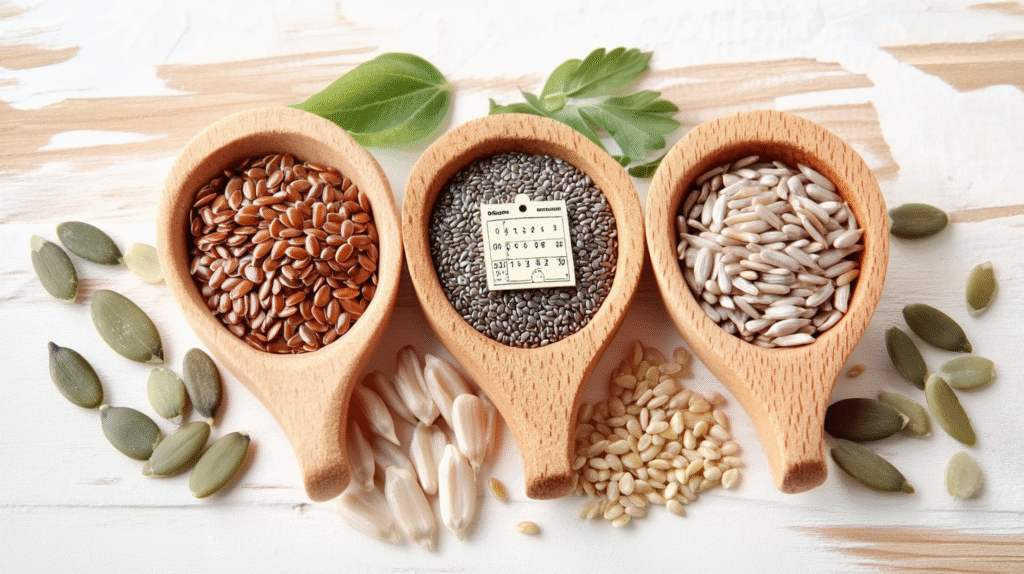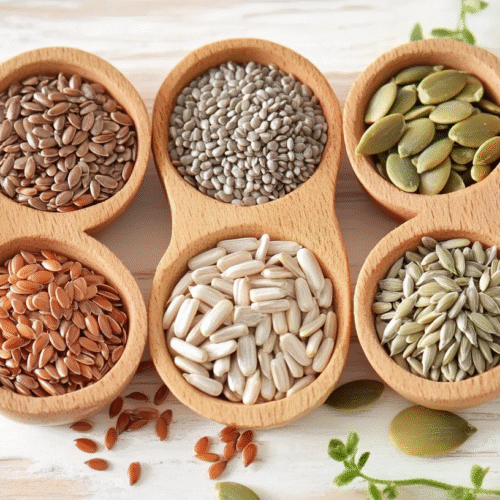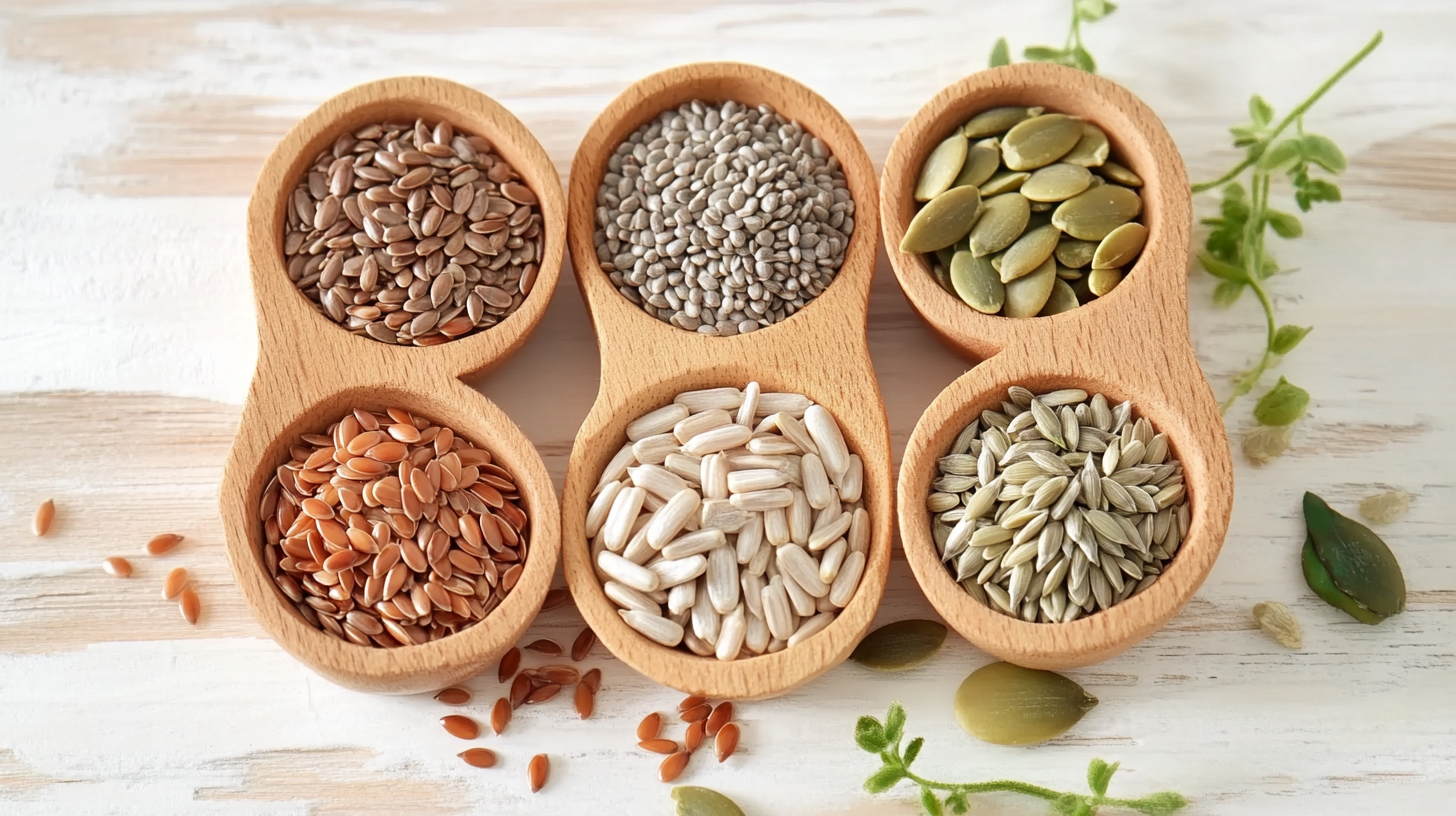Seed cycling has emerged as a natural and effective approach to supporting hormone health and promoting weight loss. This practice involves consuming specific seeds during different phases of your menstrual cycle to naturally balance hormones and optimize metabolic function. The benefits of seed cycling for hormone health and weight loss extend beyond simple nutrition, offering a holistic approach to wellness that many women are discovering as a gentle alternative to synthetic hormone treatments.
Hormonal imbalances can significantly impact weight management, energy levels, mood, and overall health. When hormones like estrogen, progesterone, and insulin are out of sync, the body often struggles to maintain a healthy weight and optimal metabolic function. Seed cycling addresses these challenges by providing essential nutrients that support natural hormone production and regulation.
What is Seed Cycling?
Seed cycling is a naturopathic practice that involves eating specific seeds during the two main phases of the menstrual cycle to support hormonal balance. During the follicular phase (days 1-14), practitioners consume pumpkin seeds and flax seeds, which contain compounds that support estrogen production and metabolism. During the luteal phase (days 15-28), the focus shifts to sunflower seeds and sesame seeds, which provide nutrients that support progesterone production.
This practice is based on the understanding that different seeds contain unique combinations of healthy fats, lignans, and minerals that can influence hormone production and metabolism. The strategic timing of seed consumption aims to work in harmony with the body’s natural hormonal fluctuations throughout the menstrual cycle.
The Science Behind Seed Cycling for Hormone Balance
Follicular Phase Support (Days 1-14)
During the first half of the menstrual cycle, estrogen levels naturally rise to prepare the body for ovulation. Flax seeds and pumpkin seeds provide crucial support during this phase:
Flax Seeds: Rich in lignans, which are plant compounds that can help metabolize excess estrogen while supporting healthy estrogen levels. Flax seeds also contain omega-3 fatty acids that reduce inflammation and support overall hormonal health.
Pumpkin Seeds: High in zinc, which is essential for hormone production and regulation. Zinc deficiency can lead to hormonal imbalances that affect both reproductive health and weight management.
Luteal Phase Support (Days 15-28)
After ovulation, progesterone levels should naturally increase to maintain hormonal balance. Sesame seeds and sunflower seeds provide targeted nutrition during this phase:
Sesame Seeds: Contain lignans that support progesterone production and help maintain healthy estrogen-to-progesterone ratios. They’re also rich in healthy fats that support hormone synthesis.
Sunflower Seeds: High in vitamin E and selenium, which support progesterone production and help reduce inflammation that can interfere with hormonal balance.
Benefits of Seed Cycling for Hormone Health
Natural Hormone Regulation
One of the primary benefits of seed cycling for hormone health is its ability to support the body’s natural hormone production and regulation processes. Unlike synthetic hormone treatments, seed cycling works with the body’s existing systems to promote balance gradually and sustainably.
The lignans found in flax seeds and sesame seeds act as phytoestrogens, which can help modulate estrogen activity in the body. When estrogen levels are too high, these compounds can help reduce estrogenic activity. When estrogen levels are too low, they can provide mild estrogenic support.
Improved Menstrual Health
Regular seed cycling practice often leads to improvements in menstrual cycle regularity, reduced PMS symptoms, and decreased menstrual cramping. The anti-inflammatory properties of the omega-3 fatty acids found in these seeds help reduce the production of inflammatory prostaglandins that contribute to menstrual pain and discomfort.
Enhanced Mood and Energy
Hormonal imbalances often manifest as mood swings, anxiety, depression, and fatigue. The nutrients provided through seed cycling, particularly the B vitamins, magnesium, and healthy fats, support neurotransmitter production and help stabilize mood and energy levels throughout the menstrual cycle.
Benefits of Seed Cycling for Weight Loss
Metabolic Support
The benefits of seed cycling for weight loss are closely tied to its effects on hormonal balance. When hormones are balanced, the body’s metabolism functions more efficiently, making it easier to maintain a healthy weight or lose excess pounds.
Insulin sensitivity often improves with better hormonal balance, which means the body is more effective at processing carbohydrates and less likely to store excess glucose as fat. The healthy fats in seeds also help regulate blood sugar levels and reduce cravings for processed foods.
Appetite Regulation
The protein and healthy fats found in seeds help promote satiety and reduce overall calorie intake. Flax seeds, in particular, are high in fiber, which expands in the stomach and creates a feeling of fullness that can help prevent overeating.
Reduced Inflammation
Chronic inflammation can interfere with weight loss by disrupting hormonal signaling and slowing metabolism. The omega-3 fatty acids and antioxidants found in seeds help reduce systemic inflammation, creating a more favorable environment for weight loss.
Improved Digestion
Many of the seeds used in seed cycling are excellent sources of fiber, which supports healthy digestion and regular bowel movements. Improved digestive health can reduce bloating and support the body’s natural detoxification processes, both of which contribute to a healthier weight.
How to Practice Seed Cycling
Basic Seed Cycling Protocol
Follicular Phase (Days 1-14):
- 1 tablespoon ground flax seeds daily
- 1 tablespoon raw pumpkin seeds daily
Luteal Phase (Days 15-28):
- 1 tablespoon ground sesame seeds daily
- 1 tablespoon raw sunflower seeds daily
Preparation and Storage
Seeds should be consumed fresh and properly stored to maintain their nutritional value. Flax seeds and sesame seeds should be ground fresh daily or stored in the refrigerator for up to one week after grinding. Grinding increases the bioavailability of nutrients and makes them easier to digest.
Pumpkin seeds and sunflower seeds can be consumed whole but should be raw and unsalted to maximize their nutritional benefits. Store all seeds in airtight containers in a cool, dry place or refrigerate to extend freshness.
Integration into Daily Routine
Seeds can be easily incorporated into meals and snacks throughout the day. Add them to smoothies, yogurt, oatmeal, salads, or simply eat them as a snack. The key is consistency – consuming the appropriate seeds daily during each phase of the cycle.
Nutritional Profile of Seed Cycling Seeds
Flax Seeds
Flax seeds are nutritional powerhouses containing omega-3 fatty acids, lignans, fiber, and protein. One tablespoon of ground flax seeds provides approximately 37 calories, 3 grams of fat, 2 grams of carbohydrates, and 1.3 grams of protein. The high lignan content makes flax seeds particularly valuable for hormonal health.
Pumpkin Seeds
Pumpkin seeds are excellent sources of zinc, magnesium, and healthy fats. One tablespoon provides about 47 calories, 4 grams of fat, 1.5 grams of carbohydrates, and 2 grams of protein. The zinc content is particularly important for hormone production and immune function.
Sesame Seeds
Sesame seeds contain lignans, healthy fats, and minerals including calcium and magnesium. One tablespoon provides approximately 52 calories, 4.5 grams of fat, 2 grams of carbohydrates, and 1.6 grams of protein. The lignan sesamin found in sesame seeds has been studied for its potential metabolic benefits.
Sunflower Seeds
Sunflower seeds are rich in vitamin E, selenium, and healthy fats. One tablespoon provides about 51 calories, 4.5 grams of fat, 2 grams of carbohydrates, and 1.5 grams of protein. Vitamin E acts as a powerful antioxidant that supports overall health and hormone function.

Expected Timeline and Results
Short-term Effects (1-3 months)
Most women begin to notice subtle changes in their menstrual cycles and overall well-being within the first few months of consistent seed cycling. These may include more regular cycles, reduced PMS symptoms, improved energy levels, and better mood stability.
Weight loss benefits may become apparent during this timeframe as well, particularly if hormonal imbalances were contributing to weight gain or difficulty losing weight. However, seed cycling should be viewed as a long-term lifestyle practice rather than a quick fix.
Long-term Benefits (3-6 months and beyond)
The full benefits of seed cycling for hormone health and weight loss typically become more apparent after several months of consistent practice. This includes more significant improvements in cycle regularity, sustained weight management, better sleep quality, and overall hormonal balance.
It’s important to remember that individual results vary based on factors such as starting hormone levels, overall diet and lifestyle, stress levels, and underlying health conditions.
Complementary Lifestyle Practices
Stress Management
Chronic stress can interfere with hormonal balance and weight management, potentially reducing the effectiveness of seed cycling. Incorporating stress-reduction techniques such as meditation, yoga, deep breathing exercises, or regular physical activity can enhance the benefits of seed cycling.
Sleep Optimization
Quality sleep is crucial for hormone production and regulation. Aim for 7-9 hours of consistent, quality sleep each night to support your body’s natural hormonal rhythms and maximize the benefits of seed cycling.
Balanced Nutrition
While seed cycling provides targeted nutritional support, maintaining an overall balanced diet rich in whole foods, lean proteins, healthy fats, and plenty of vegetables will enhance its effectiveness for both hormone health and weight management.
Regular Exercise
Physical activity supports hormonal balance, improves insulin sensitivity, and aids in weight management. Combine cardiovascular exercise with strength training for optimal results, and consider the timing of intense workouts in relation to your menstrual cycle.
Potential Considerations and Precautions
Individual Variability
While many women experience positive results from seed cycling, individual responses can vary. Some may notice changes quickly, while others may need several months to see significant improvements. Patience and consistency are key to success.
Quality and Source of Seeds
The quality of seeds used in seed cycling can significantly impact results. Choose organic, raw, and minimally processed seeds whenever possible. Avoid seeds that have been roasted, salted, or processed with oils, as these may contain harmful additives and have reduced nutritional value.
Allergies and Sensitivities
Some individuals may have allergies or sensitivities to certain seeds. Start with small amounts and monitor for any adverse reactions. If you experience digestive upset, skin reactions, or other concerning symptoms, discontinue use and consult with a healthcare provider.
Medical Conditions
Women with certain medical conditions, particularly those affecting hormone levels such as PCOS, endometriosis, or thyroid disorders, should consult with healthcare providers before beginning seed cycling. While generally safe, seed cycling may interact with certain medications or medical treatments.
Seed Cycling Recipe Ideas
Hormone-Balancing Smoothie (Follicular Phase)
Ingredients:
- 1 cup unsweetened almond milk
- 1 tablespoon ground flax seeds
- 1 tablespoon raw pumpkin seeds
- 1/2 frozen banana
- 1 cup spinach
- 1 tablespoon almond butter
- 1 teaspoon vanilla extract
- Ice cubes as needed
Instructions:
- Combine all ingredients in a high-speed blender
- Blend until smooth and creamy
- Pour into a glass and enjoy immediately
- Consume daily during the follicular phase
Luteal Phase Power Bowl
Ingredients:
- 1 tablespoon ground sesame seeds
- 1 tablespoon raw sunflower seeds
- 1/2 cup cooked quinoa
- 1 cup mixed greens
- 1/4 avocado, sliced
- 2 tablespoons tahini dressing
- 1 tablespoon hemp hearts
Instructions:
- Prepare quinoa according to package directions and let cool
- Arrange mixed greens in a bowl
- Top with cooled quinoa, avocado slices, and hemp hearts
- Sprinkle sesame seeds and sunflower seeds over the bowl
- Drizzle with tahini dressing and enjoy


Seed Cycling Smoothie & Power Bowl
Equipment
- Blender
- Mixing Bowl
Ingredients
Follicular Phase Smoothie
- 1 cup unsweetened almond milk
- 1 tbsp ground flax seeds
- 1 tbsp raw pumpkin seeds
- 0.5 frozen banana
- 1 cup spinach
- 1 tbsp almond butter
- 1 tsp vanilla extract
Luteal Phase Power Bowl
- 1 tbsp ground sesame seeds
- 1 tbsp raw sunflower seeds
- 0.5 cup cooked quinoa
- 1 cup mixed greens
- 0.25 avocado sliced
- 2 tbsp tahini dressing
- 1 tbsp hemp hearts
Instructions
- For Smoothie: Combine all smoothie ingredients in a blender and blend until smooth. Serve immediately.
- For Power Bowl: Arrange greens in a bowl, top with cooked quinoa, avocado, and hemp hearts. Sprinkle seeds and drizzle tahini dressing. Serve fresh.
Notes
Frequently Asked Questions
Does seed cycling help you lose weight?
Yes, seed cycling can support weight loss efforts by helping to balance hormones that regulate metabolism, appetite, and fat storage. When hormones like insulin, estrogen, and progesterone are balanced, the body is more efficient at processing nutrients and less likely to store excess calories as fat. However, seed cycling should be combined with a healthy diet and regular exercise for optimal weight loss results.
How long does it take for seed cycling to balance hormones?
Most women begin to notice subtle improvements in hormonal symptoms within 1-3 months of consistent seed cycling practice. However, significant hormonal balance typically requires 3-6 months or longer, as it takes time for the body to adjust and for new, healthier hormone patterns to establish. Consistency is crucial – missing days or cycles can delay results.
What are the benefits of seed cycling for hormones?
The primary benefits of seed cycling for hormones include natural regulation of estrogen and progesterone levels, improved menstrual cycle regularity, reduced PMS symptoms, better mood stability, increased energy levels, and enhanced overall reproductive health. The practice supports the body’s natural hormone production processes rather than introducing synthetic hormones.
How long does it take for flaxseed to balance hormones?
Flaxseed can begin to influence hormone metabolism within a few weeks of regular consumption, but noticeable improvements in hormonal balance typically take 2-3 months of consistent daily intake. The lignans in flaxseed work gradually to support healthy estrogen metabolism, so patience and consistency are essential for seeing results.
Conclusion
The benefits of seed cycling for hormone health and weight loss make this natural practice an attractive option for women seeking to support their hormonal balance without synthetic interventions. By strategically consuming specific seeds during different phases of the menstrual cycle, women can provide their bodies with targeted nutrition that supports natural hormone production and regulation.
Success with seed cycling requires patience, consistency, and realistic expectations. Most women will need several months of regular practice to experience the full benefits, and results will vary based on individual factors such as starting hormone levels, overall health, and lifestyle practices.
For women interested in exploring natural approaches to hormone health and weight management, seed cycling offers a gentle, food-based method that works with the body’s natural rhythms. Combined with other healthy lifestyle practices such as stress management, quality sleep, regular exercise, and balanced nutrition, seed cycling can be an effective tool for supporting overall hormonal wellness and achieving sustainable weight management goals.
Remember that while seed cycling can provide significant benefits for many women, it’s always wise to consult with healthcare providers, particularly if you have existing medical conditions or are taking medications that might interact with dietary changes. With proper guidance and consistent practice, the benefits of seed cycling for hormone health and weight loss can contribute to improved overall wellness and quality of life.
Disclaimer: This article is for informational purposes only and should not be considered medical advice. Always consult with qualified healthcare professionals before making significant changes to your diet or health routine, especially if you have existing medical conditions or take medications.

